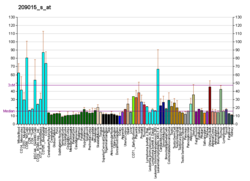DNAJB6
DnaJ 상동 서브 패밀리 B 구성원 6은 인간에서 DNAJB6 유전자에 의해 암호화되는 단백질이다.[5][6][7]
기능[편집]
이 유전자는 DNAJ 단백질 패밀리의 구성원을 암호화한다. DNAJ 패밀리 구성원은 'J 도메인'이라 불리는 아미노산 가닥을 특징으로 하며, 단백질 접힘 및 올리고머 단백질 복합체와 같은 광범위한 세포에 관여하는 샤페로닌의 2가지 주요 부류 중 하나로서 기능한다. 이 패밀리 구성원은 특정 뉴런에서 폴리 글루타민 응집에 역할을 할 수도 있다. 이 유전자의 대안적 스플라이싱은 다수의 전사 변이체를 초래한다. 그러나 모든 변형이 완전히 설명된 것은 아니다.[7]
상호 작용[편집]
DNAJB6는 케라틴 18과 상호 작용하는 것으로 나타났다.[8] 또한 Aβ42은 DNAJB6에 의해 농도 의존적 방식으로 지연되고, 화학량론적 몰비의 샤페로닌 대 펩타이드의 매우 낮은 화학량론적 몰비로 확장된다.[9]
각주[편집]
- ↑ 가 나 다 GRCh38: Ensembl release 89: ENSG00000105993 - 앙상블, May 2017
- ↑ 가 나 다 GRCm38: Ensembl release 89: ENSMUSG00000029131 - 앙상블, May 2017
- ↑ “Human PubMed Reference:”. 《National Center for Biotechnology Information, U.S. National Library of Medicine》.
- ↑ “Mouse PubMed Reference:”. 《National Center for Biotechnology Information, U.S. National Library of Medicine》.
- ↑ “Cloning, tissue expression, and chromosomal assignment of human MRJ gene for a member of the DNAJ protein family”. 《J Hum Genet》 44 (3): 185–9. June 1999. doi:10.1007/s100380050139. PMID 10319584.
- ↑ Pei L (March 1999). “Pituitary tumor-transforming gene protein associates with ribosomal protein S10 and a novel human homologue of DnaJ in testicular cells”. 《J Biol Chem》 274 (5): 3151–8. doi:10.1074/jbc.274.5.3151. PMID 9915854.
- ↑ 가 나 “Entrez Gene: DNAJB6 DnaJ (Hsp40) homolog, subfamily B, member 6”.
- ↑ “Identification of Mrj, a DnaJ/Hsp40 family protein, as a keratin 8/18 filament regulatory protein”. 《J. Biol. Chem.》 275 (44): 34521–7. 2000. doi:10.1074/jbc.M003492200. PMID 10954706.
- ↑ Månsson, C; Arosio, P; Hussein, R; Kampinga, H H; Hashem, R M; Boelens, W C; Emanuelsson, C (2014). “Interaction of the molecular chaperone DNAJB6 with growing amyloid-beta 42 (Aβ42) aggregates leads to sub-stoichiometric inhibition of amyloid formation.”. 《J. Biol. Chem.》 289 (45): 31066–76. doi:10.1074/jbc.M114.595124. PMC 4223311. PMID 25217638.






